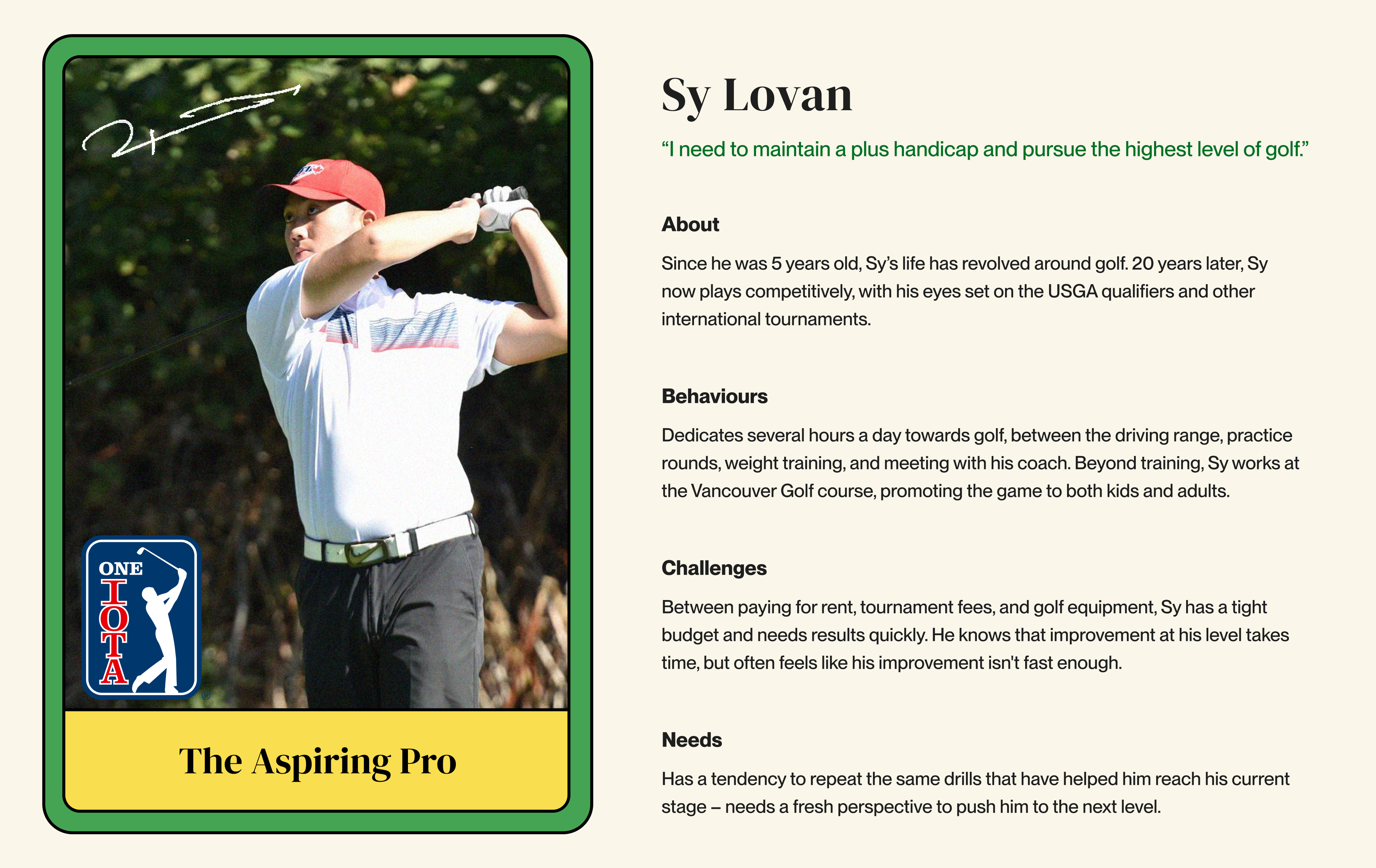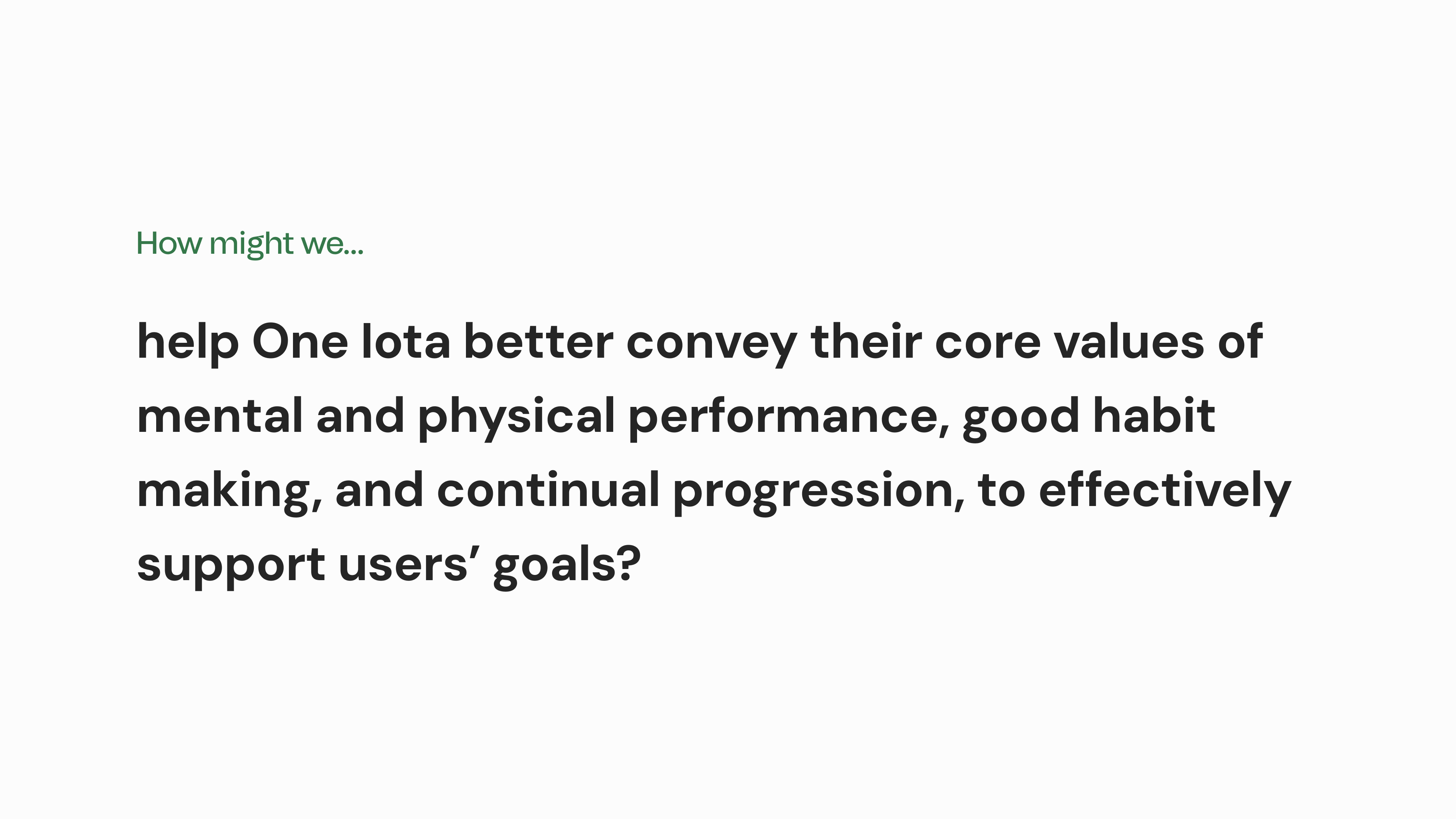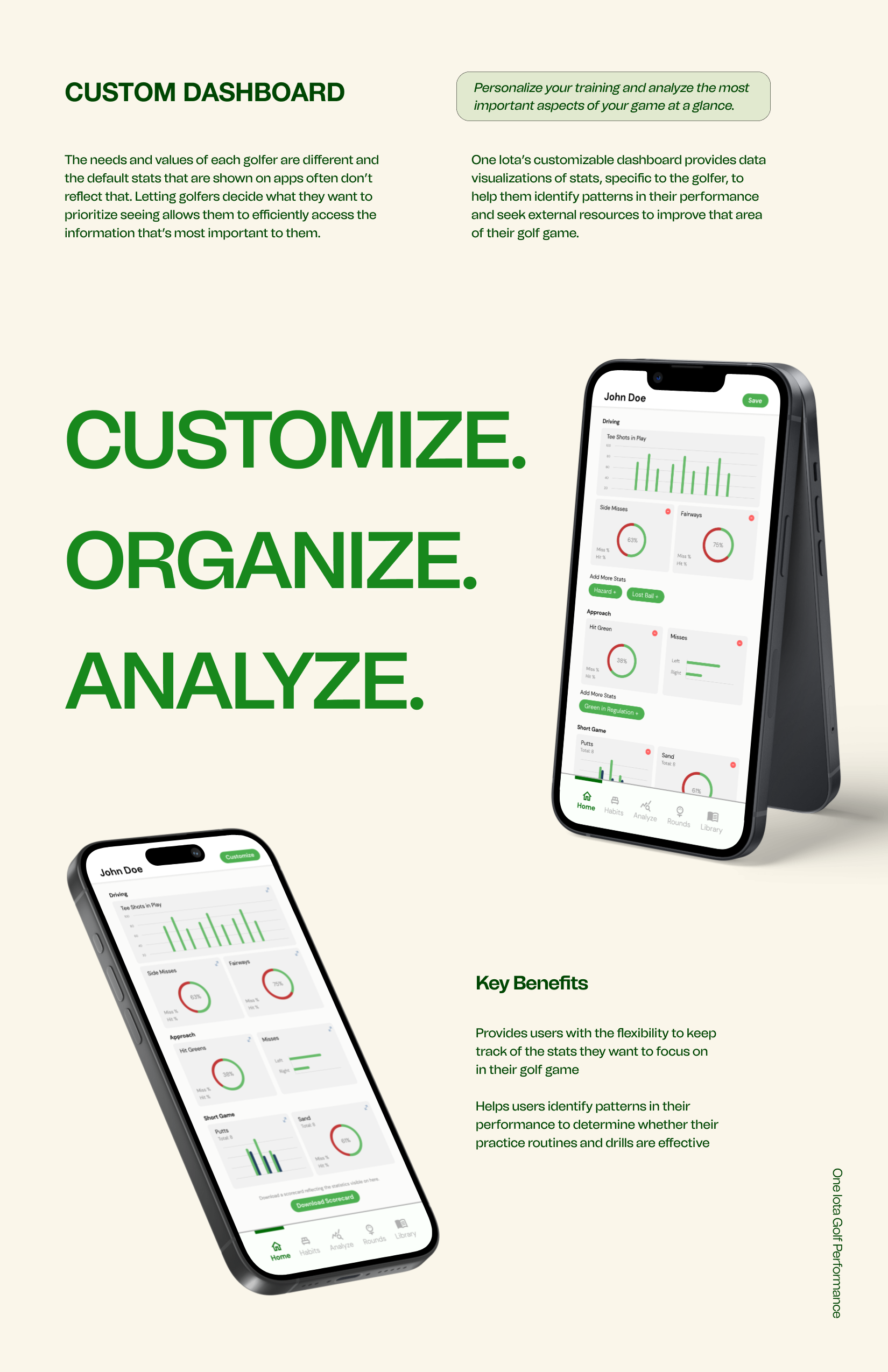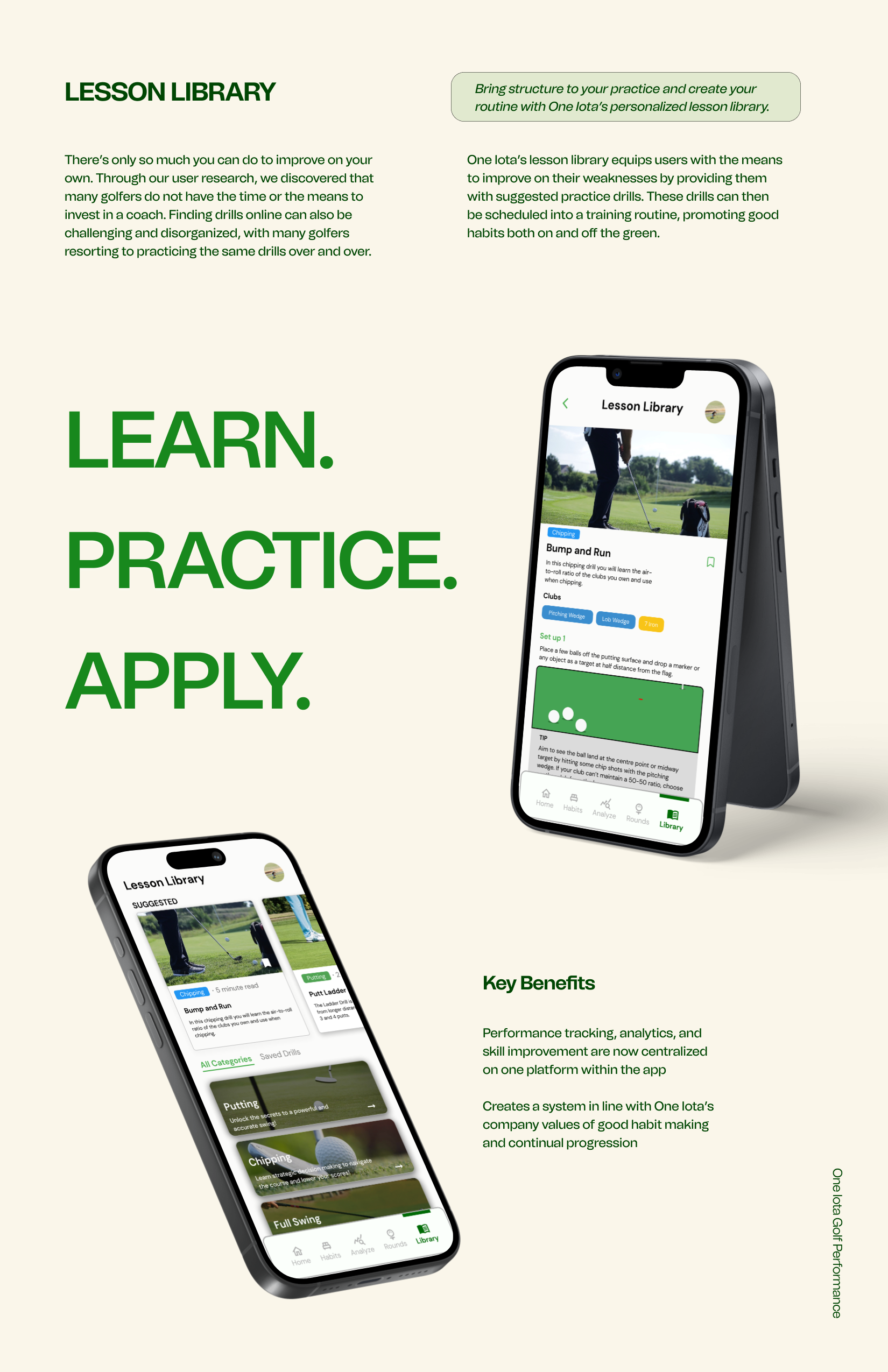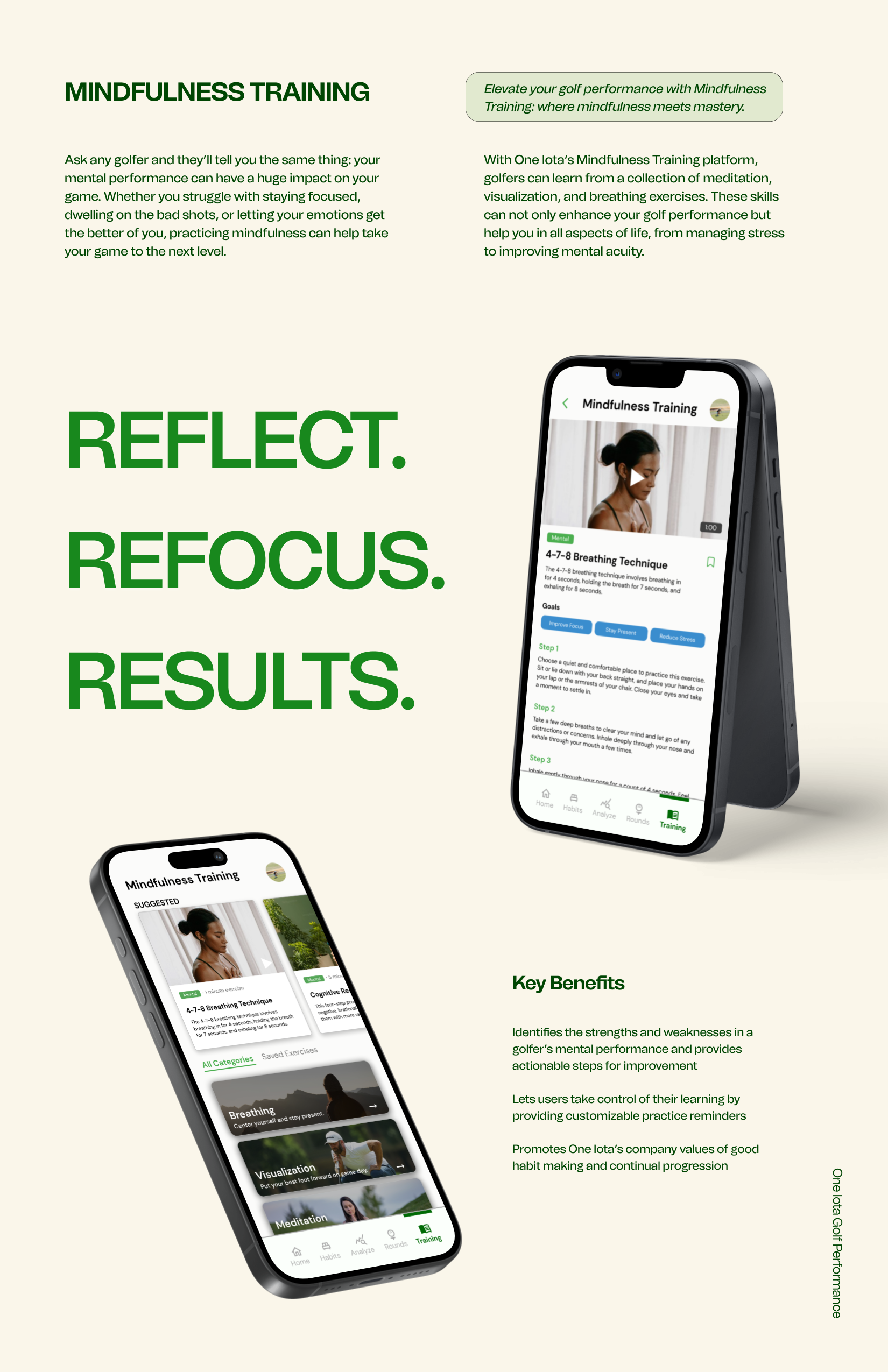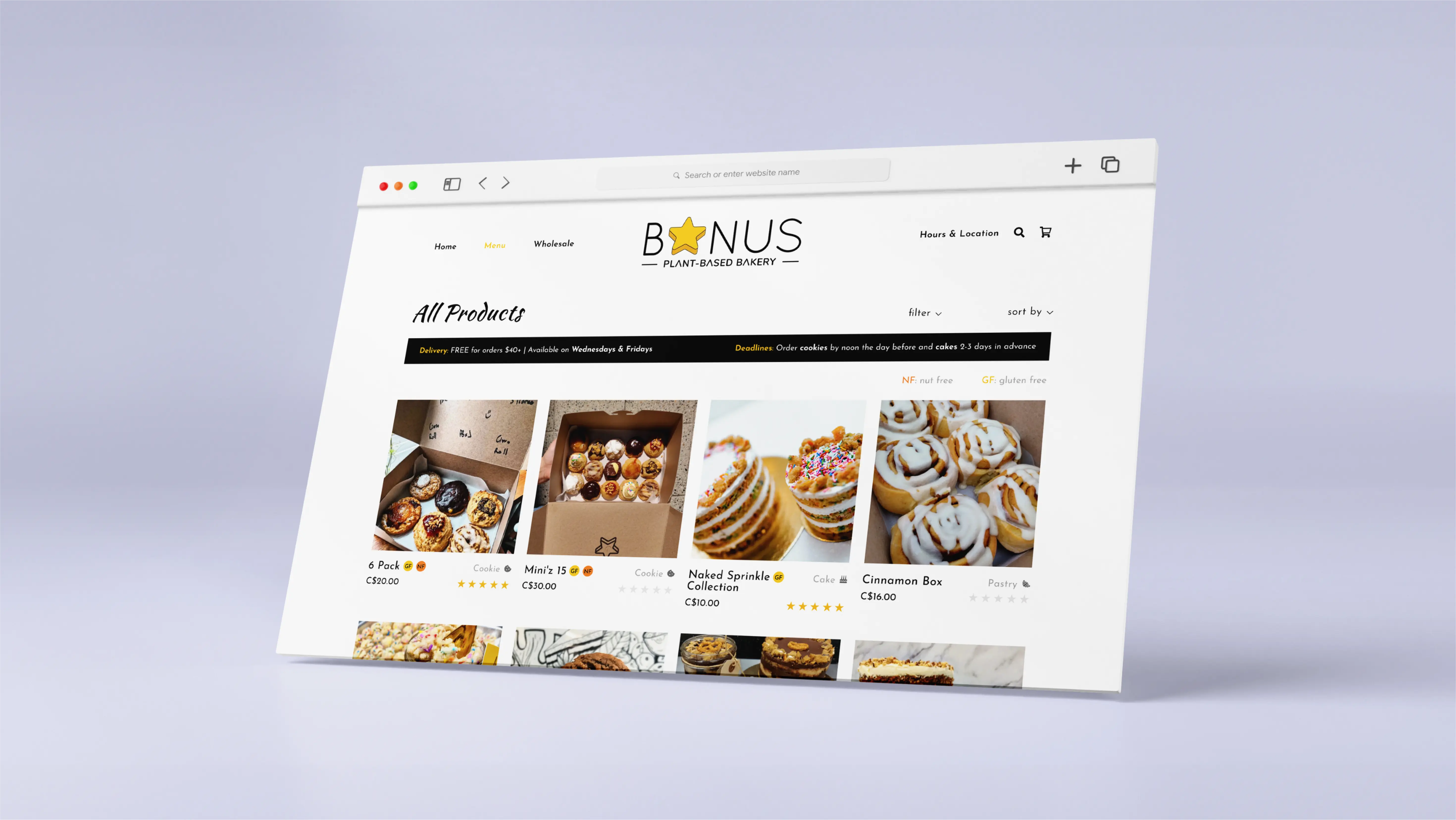One Iota Training Library
Equipping golfers with personalized training through data analysis and actionable insights.
OVERVIEW
Timeline
3 months (Sep - Dec 2023)
Team
5 UX Researchers and Designers
Toolkit
Figma, Miro, Zoom, SurveyMonkey, Premiere Pro
Role
As a UX Researcher and Designer, I conducted user interviews, online surveys, journey mapping, and co-hosted a participatory workshop to understand the needs of amateur and professional golfers. I also produced a concept video to highlight the key features and context of use for our platform.
Deliverables
The final deliverables included a prototype of the proposed feature, a concept guide, a concept video, and a client presentation.
Status
Live: The One Iota Training Library is currently available for public access on mobile and desktop platforms.
INTRODUCTION
Context
This project was completed as part of a senior level interaction design course at Simon Fraser University. The objective was to partner with a local business to analyze the interactions within their products, services, or operations, and to design a technology solution to improve some area of process.
Process Overview
STARTING POINT
The Client
One Iota Performance Inc, a golf analytics company in Vancouver, BC.
Launched in 2023, One Iota Performance is a golf analytics platform that provides avid golfers with data-driven insights to analyze and improve their game. Through the desktop and mobile apps, athletes can input data about each round, reflect on their mental and physical performance, and uncover their strengths and weaknesses.
With so many golf analytics apps on the market, One Iota aims to differentiate itself by placing equal emphasis on mental and physical performance, encouraging good habit making, and equipping golfers with the tools to make continual progress, one iota at a time.
The Starting Point
Investigating the onboarding process' high drop-off rate.
In our initial meeting, our client noted that many new users were dropping off during the onboarding process, so our team aimed to explore this issue further. Was the onboarding process too complicated? Is the key value not communicated effectively? Or are there any other factors at play?
The Plan
A double diamond approach: designing the right thing before designing things right.
Our team decided to begin with exploratory user research to gain an ethnographic understanding of the habits, needs, and pain points of professional and amateur golfers.
Based on our findings, our team then conducted several rounds of concept exploration and refinement, incorporating feedback and critique from key stakeholders, to ensure the final product met both business needs and user requirements.
EXPLORATORY RESEARCH
User Interviews and Surveys
Understanding existing perceptions and experiences with performance tracking apps.
To start off our research, our team conducted ride-along interviews with one amateur and two competitive golfers to observe their experiences with One Iota’s onboarding process and user interface first-hand.
I also designed an online survey to gain broader insight into golfers’ existing perceptions and experiences with performance tracking apps in general, reaching 58 participants.
INSIGHT #1
Mental performance is a very high priority for dedicated golfers.
INSIGHT #2
Users want to understand their weaknesses, but don't always know how to improve – especially the 50% of One Iota users who do not have a coach.
INSIGHT #3
The onboarding process is tedious but not the root cause of low user conversion and retention.
📌 Personal Takeaways
I didn’t know much about golfers... or golf. Ethnographic research to the rescue!
Initially, our team did not have enough golf knowledge to understand whether One Iota’s existing features provided value to users. However, in-depth conversations and observational ride-alongs with golfers unveiled a deeper understanding of golf culture, including an unspoken rule of not using cell phones on the course and a common drive for improvement and excellence.
SYNTHESIZING KEY FINDINGS
User Personas
Focusing on dedicated amateur and aspiring professional golfers.
Upon analyzing our initial research and examining the demographics and psychographics of One Iota's current users, two main personas emerged: the dedicated amateur and the aspiring pro.
Journey Maps
Mapping the experiences of our personas to identify design opportunities.
To better visualize potential opportunities to intervene, we created two journey maps to outline the actions, challenges, and emotions that our personas would face when using One Iota's app, from deciding to play a round of golf to creating their action plan for improving their game afterwards. I was responsible for creating the journey map for the dedicated amateur.
Key Findings
Both user groups shared three main challenges in their journey.
PAIN POINT #1
Providing too many statistics can lead to information overload, making it difficult to pinpoint the most relevant information to users' growth and development.
PAIN POINT #2
The current mental performance analysis is difficult to interpret.
After each round of golf, users complete a mental performance reflection survey. The app analyzes their responses and produces a mental performance score based on several aspects, such as concentration and positive thinking. However, users only receive the score (i.e., 70/100), and it is difficult to interpret what this number actually means.
PAIN POINT #3
Highlighting weaknesses is meaningless without offering resources for improvement. Currently, users must share the app's analysis with their coach or find resources on their own.
NARROWING OUR DESIGN FOCUS
DESIGN EXPLORATION
Concept Ideation
Generating three concepts to address current pain points.
Guided by our design focus, our team explored three concept directions: a customizable dashboard, a lesson library, and a mindfulness training platform. For each idea, we created a concept poster and storyboard to illustrate the benefits to each persona and its incorporation into their user journeys. I was responsible for creating the Mindfulness Training journey map and writing the content for the three concept posters.
Concept posters (click to expand)
Concept storyboards (click to expand)
VALIDATION AND REFINEMENT
Participatory Workshop
Co-hosted a 1.5 hour long workshop on Zoom and Miro with five stakeholders to validate and refine our concepts.
Key Questions
- Is One Iota effectively communicating their core values to their users?
- Are One Iota users’ needs being met and are the current/proposed features in line with their values?
- What would it take to make users of competing apps switch to One Iota?
Participants
- 2 current One Iota users (one amateur and one professional golfer)
- 1 app developer, a co-founder of One Iota
- 1 mental training coach, a co-founder of One Iota
- 1 user of a competing golf app
Activities
- An Idea Sprint was used to quickly determine the top five factors influencing user decisions to choose or switch to a different golf performance tracking app. This provided an open-ended way to discover what qualities were most important to users.
- The Brand Identity Moodboard activity provided a comparison between how One Iota wanted to be perceived and how they are currently perceived by current and prospective users.
- The final Feature Ranking activity helped our team gauge which existing and proposed features were most feasible and valuable to each of our user groups.
Key Findings
Three common themes emerged throughout our workshop.
INSIGHT #1
Users want actionable steps to reach their goals.
INSIGHT #2
One Iota and its users were aligned on the importance of mental performance.
INSIGHT #3
Mental training was priority for professional golfers, while the lesson library was more valuable to amateur golfers.
📌 Personal Takeaways
Language matters!
One interesting insight from our workshop was how everyone preferred the phrase "Mental Training" over "Mindfulness Training". Some participants mentioned associating "mindfulness" with relaxation and calm, while "mental training" implied fortitude and strength. This led our team use stronger language in our copywriting moving forward, considering the perceptions of our target audience.
FINAL SOLUTION
The One Iota Training Library
A comprehensive collection of physical drills and mental exercises to develop and improve all aspects of your golf game.
Drawing on insights from our stakeholder workshop, our team evolved our concept into a unified training library, offering mental and technical training within a single, comprehensive platform.
I developed a concept poster and storyboard for the Training Library, emphasizing its advantages for our user groups and its significant impact on their user journeys.
This concept was then presented to our client, who was delighted with its alignment with the company’s core values, business objectives, and user requirements. This gave our team the green light to move forward with creating a high-fidelity prototype in Figma.
FINAL DELIVERABLES
Experience the Final Prototype
Concept Video
Showcasing key features, user benefits, and use case scenarios.
To conclude the project, I created a product video to illustrate the key features of our application and showcase the context in which it would be used.
CONCLUSION
Final Takeaways
Ethnographic research can uncover unique opportunities and challenges, especially when designing for an unfamiliar user group.
One of the key challenges in this project was my unfamiliarity with golf, as I did not have any background knowledge on the habits and needs of golfers or the nuances of the sport.
This created a fantastic opportunity to leverage my existing research experience in designing surveys and conducting interviews, while developing new skills in running stakeholder workshops and crafting in-depth user journey maps. This approach allowed for a deeper exploration into the intricacies of golf and the emerging design opportunities, while ensuring our final solution aligned with business objectives and user needs.
The opportunity to help a local start-up further develop their product and strengthen their market position was also extremely rewarding, and further affirmed my interest in pursuing a career in user experience research!


